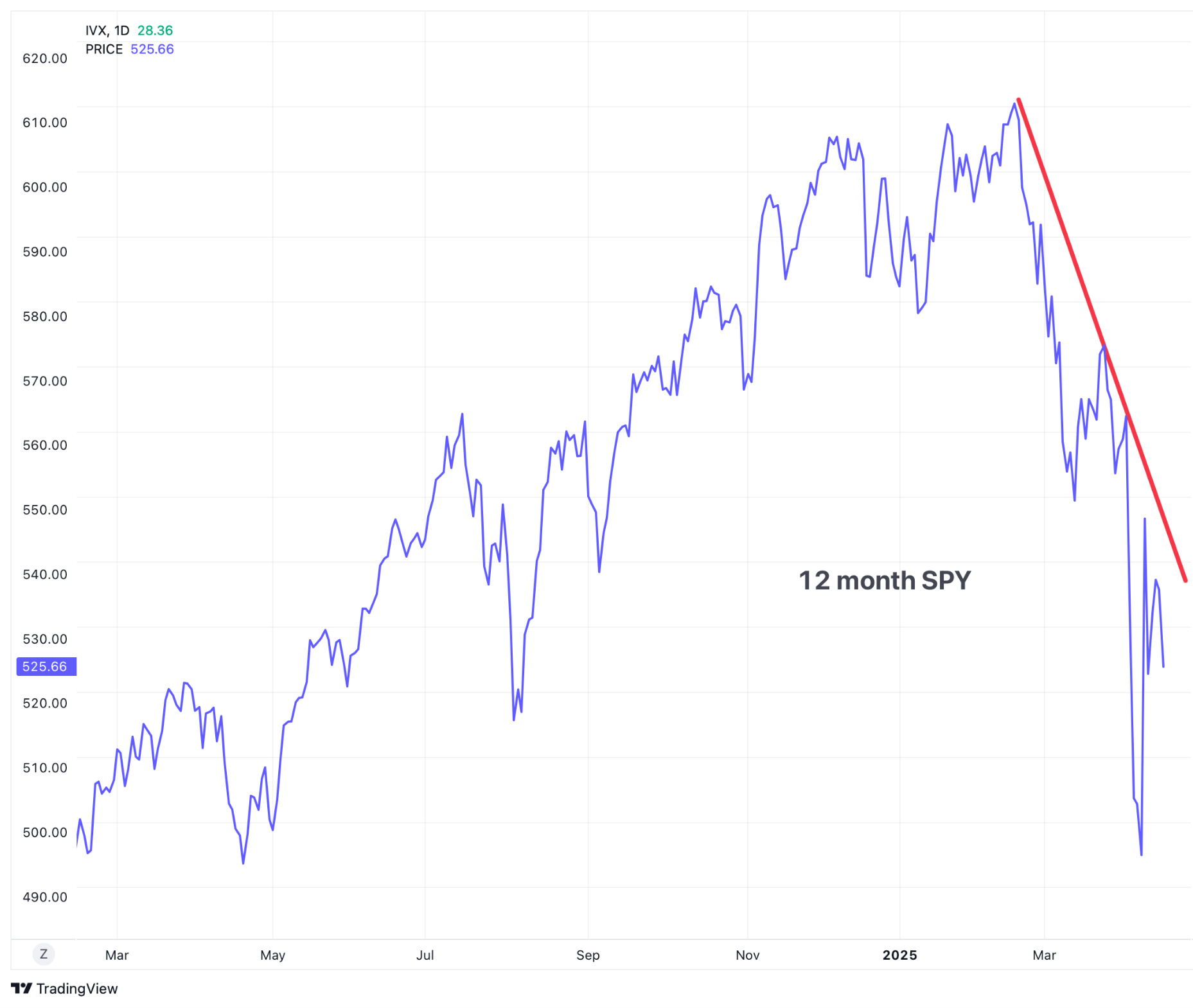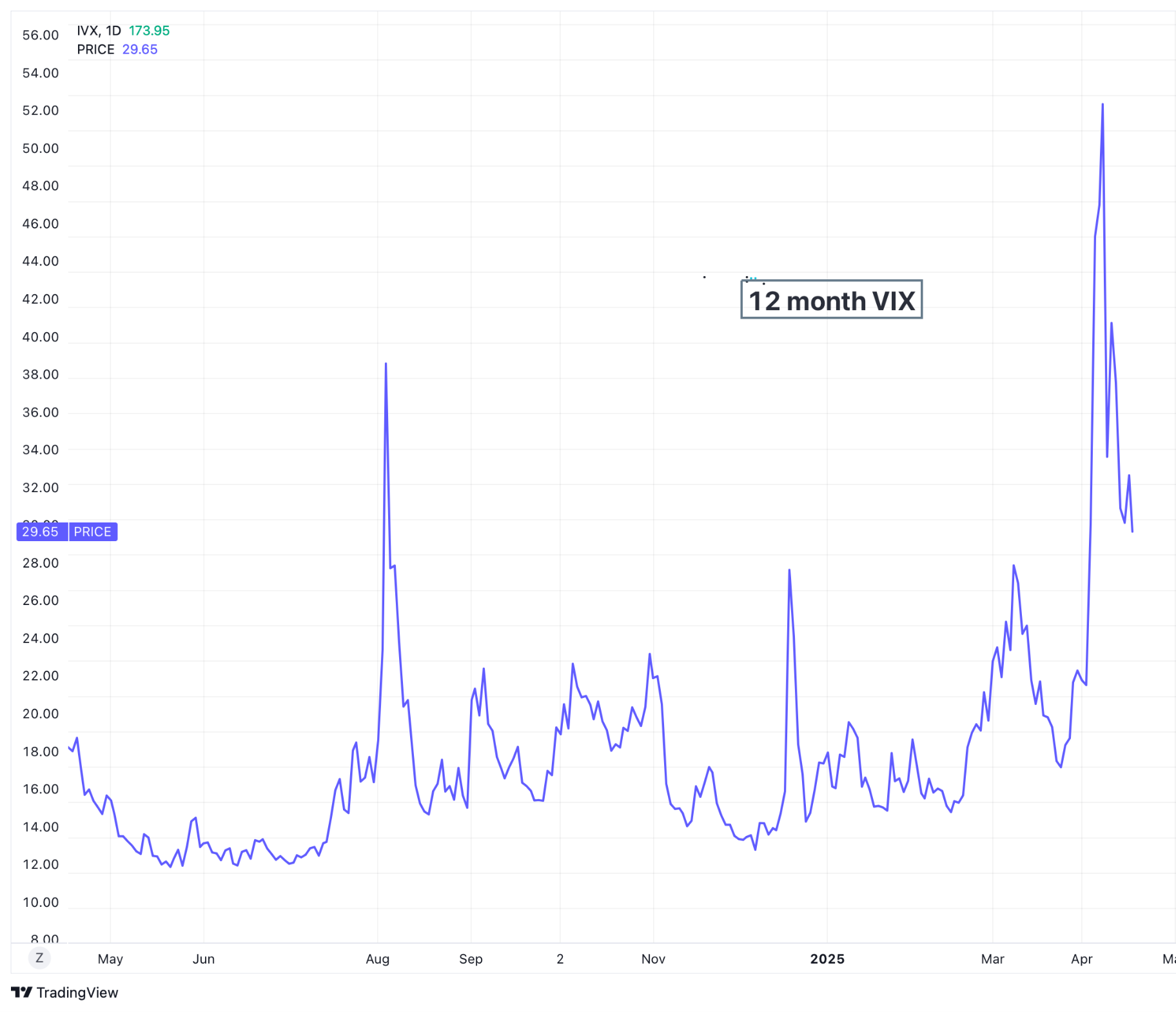Markets In Turmoil
April 18, 2025
The Markets at a Glance
Basically, financial markets were rattled by the US administration's tariff policies. Are tariffs on or off? Are there any exceptions, and if so, are the exceptions temporary or permanent? Are there retaliations from the receiving countries?
Some items under consideration:
- Will the market low of 4800 be challenged again?
- Investors are still on edge with gold rallying out of control, the bond market "very sick" with an 11 handle move in 7 trading days and the US dollar in crash mode.
- A big cause of concern for traders is that the Capital Markets appear to be destabilized by executive orders announced by a tweet.
- Some tariff rates are big enough to almost be considered embargoes.
Some important market profiles are presented below:


Since the current US administration first announced its "reciprocal" tariffs on April 2, the S&P 500 has slid roughly 7% and the Nasdaq Composite has dropped 7.4%. The Dow has lost about 6% indicating less and less confidence that the trade wars are subsiding. Business forecasting and supply chains are difficult to establish with the constantly changing tariff calls and postponements. China and US trade war headlines continue to drive market sentiment which does not appear to be rebounding. Last week, it appeared that a rebound was gathering steam but perhaps that rebound can be written up as a bear market rally? A wait and see mode in the markets?
Investing during a trade war is a moving target even in the best of times, and straight-up impossible at the worst.
Daily Recap
Monday: Nasdaq stocks jumped after another tariff U-turn. Despite a weekend of confusing headlines regarding tariff exemptions led traders to take a more constructive approach to the Capital Markets. Signs of apparent de-escalation were welcomed, resulting in a reversal of some of last week's massive price action: Stocks and bonds were higher, while gold retreated. Unfortunately, the U.S. dollar has not been able to capitalize on the shift in sentiment.
Tuesday: The markets moved about 70 handles from high to low but ended up basically unchanged. It appeared that the markets were taking a bit of a breather. The biggest news was presentations on cable networks as to what caused the big bond drop the previous week and subsequent postponements/cancellations of certain tariffs. Some blamed the Chinese government, others claimed that a fund collapsed and was forced to sell Treasury positions to cover their losses.
Wednesday: Stocks fell sharply on Wednesday as a stark warning came from NVDA. Shares of Nvidia sank almost 7% after the chip giant said it will post a $5.5B quarterly charge related to exporting its H20 graphics processing units to China and other nations.
Markets were additionally rattled when Federal Reserve Chairman Jerome Powell expressed concerns about the economic impact of tariffs. Stocks slid to session lows after Chairman Powell indicated that the US tariffs could pose a challenge for the central bank to control inflation. This raised alarms among already skittish investors and sent gold prices screaming to new all-time highs.
The DJIA lost about 700 points, or nearly 2%. The S&P dropped over 2% and the Nasdaq Composite pulled back over 3%, sliding closer to bear market territory.
Thursday: NFLX earnings release. The future of this underlying might be fairly well-protected from the vagaries of the markets and tariffs. It presents an interesting opportunity to get long at current prices (see strategy to consider in following section).
Friday: Market holiday
Strategies to Consider
With VIX in backwardation, it does not bode well for bottom-fishing. Broad-based market etfs are possibly the best plays with low basis and high IVR. The only certainty now is that volatility is going to be lower in time.
- Iron Condor in the QQQ
duration: May 16th expiration
strikes: 380/400/480/500
delta: neutral
probability of profit: 66%
probability of 50% profit: 78%
credit received: $444
buying power held: $1550
max possible profit: $444
max potential loss: $1550
variations: short strangle, short put, short put vertical; control delta and buying power with strike selection - Short put vertical in /ZB
Getting bullish in the /ZB (lows established in the bond market last week may be viable levels of support to trade around)
duration: June 20th expiration
strikes: 105/110 put credit spread
delta: bullish
credit received: $735
buying power held: $938
max possible profit: $735
max potential loss: $4300 - Put broken wing butterfly in NFLX for earnings
expiration: April 25th
strikes: 845/885/900
delta: bullish
credit received: $300
buying power held: $2175
max possible profit: $300
max potential loss: $2200
No risk to the upside and downside breakeven around 867. - Capitalizing on continuing downside moves
Long delta buster (LDB) strategies can be employed to take advantage of downside moves in the markets. This strategy generally consists of buying an ATM put spread in the weekly expiration and financing it with the sale of a short call (or spread) in the monthly expiration. It adds negative deltas to the portfolio and the debit put spread.
Buy the SPY apr24 520/525 put spread
Sell the SPY may16 560/575 call spread
Total credit: 53c.
Buying power deployed: 1450
Breakeven: SPY at 560
Max profit: $553 if SPY expires below 520 by Apr 24th
Management: if SPY breaches 560, roll out the call spread to the next monthly duration
Max loss: if SPY expires above 575 by may 16 and no management is done upon a breach at 560
Considerations for the Coming Weeks
April expirations have historically enjoyed the highest percentage of UP closes with UP moves much stronger than down moves.
Technology stocks may have the most interesting beta plays. They are mostly liquid and present "the most bang for the buck."
Keep position sizes smaller than normal for these are not "normal" times.
Take smaller profits and cut losses sooner.
In Case You Didn't Already Know This...
Leveraged ETFs are products created for those investors that are not conversant with the use of futures or their broker does not provide access to futures. These are often referred to as poor man's futures but do not provide the capital efficiency of futures or futures options. They have an embedded negative drag and are best held for no more than 24-48 hours.
Questions / Comments
We're here to serve IVolatility users and we welcome your questions or feedback about the option strategies discussed in this newsletter. If there is something you would like us to address, we're always open to your suggestions. Use support@ivolatility.com.
Previous issues are located under the News tab on our website.